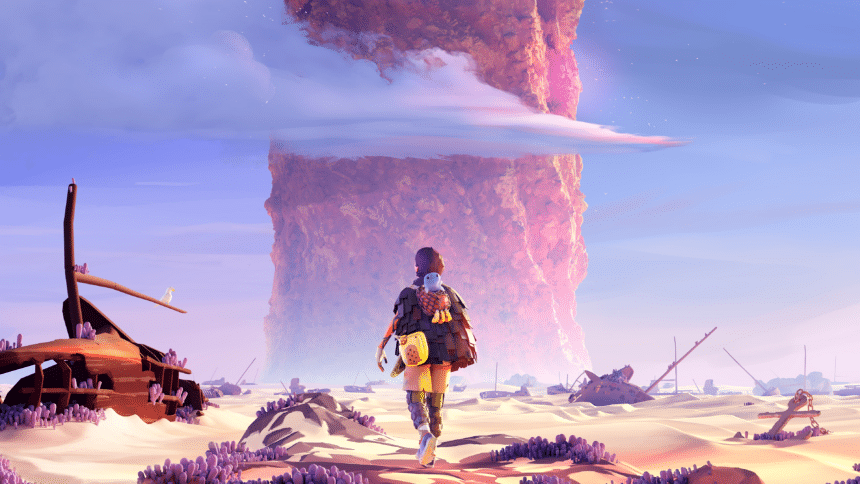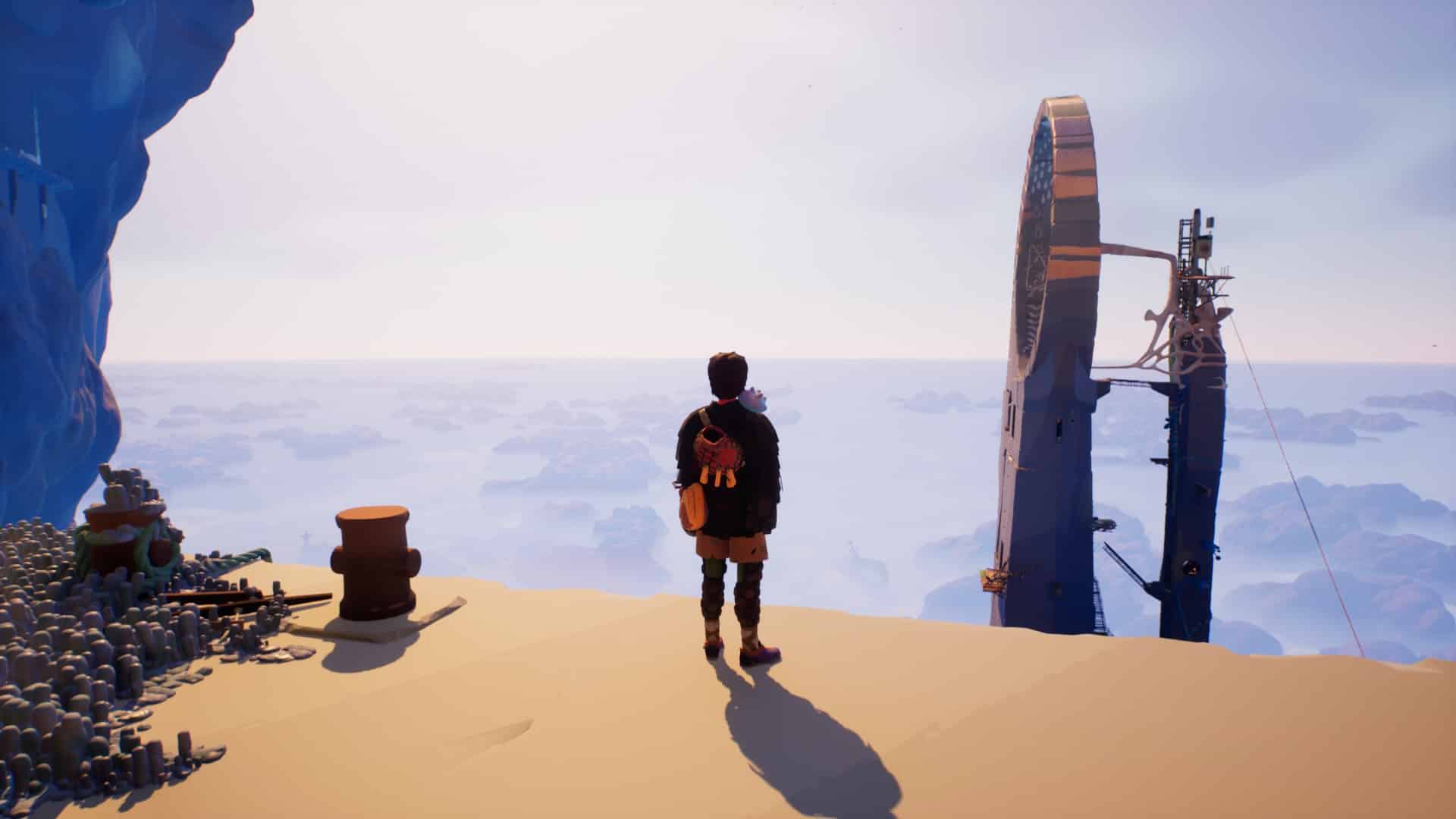I like games designed around a particular mechanic or theme. Climbing isn’t a new thing in games, and over the years, it’s become one with traversal in many open-world titles. Though, only a few of those have really made it into a mechanic that’s worth understanding, and tactfully making use of rather than just holding a button to mindlessly get it over with. Jusant celebrates the idea of climbing, and in my review, I’ll see how well it does that.
Climbing to the Top
In a nutshell, Jusant is about climbing a massive tall tower that never seems to end no matter how much you’ve scaled it. There’s no combat or enemies, but climbing this immeasurable tower is the entire challenge and your ultimate goal. You do this by using the triggers on the controller, each representing a hand. So, if you want to grip something using the right hand, you’ll hold the right trigger, and let go when you want to go up.

It’s sort of like how you grip your backpack in Death Stranding to maintain balance, and after some practice, you’ll get the hang of it. The combination of gripping, and letting go is the heart of climbing and it can be quite rewarding to see your character effortlessly switch between each hand as they scale rocks, and grab ledges to ascend. This degree of control introduces a reasonable amount of challenge requiring mastery from you as you get to the trickier sections

As you progress, you’ll have to adapt to the properties of different biomes, and the unique mechanics each offer. For example, when you’re out in the sun, your stamina drains faster, which means you’ll have to carefully choose when you want to jump, and if it’s worth losing stamina over. Keep in mind, that there is no fail-state here, you’ll always dangle by the last anchor point if you didn’t time your jump right, or failed to grab a ledge.
This takes away a lot of the frustration from the climbing aspect, and you can play at your own pace. It’s a relaxed overall experience that offers enough challenge to keep you hooked without making you feel discouraged. New traversal challenges don’t allow for repetition to set in, keeping things fresh.
Finding Your Way
You also have a companion who interacts with different elements of the world to create traversal paths. It also allows you to see where you need to go next, where a certain collectible might be, and such. In most instances, you’ll have a clear idea of where to go next, and the general direction provided by your watery companion gets the job done, but I did have some trouble in a few spots.

At times, the only way forward is often hidden in a crevice, which can lead to some frustration, especially when the companion can’t exactly pinpoint the next spot. This means that while you have freedom when the path is obvious, the game doesn’t exactly facilitate a freeform approach to navigation when it’s a bit unclear as to how you need to scale a certain section.
Compared to something like Breath of the Wild, the options are fairly limited in how you can approach the same obstacle. While it doesn’t happen as often, these few instances make the lack of choice a bit more obvious and take away from the overall spirit of climbing.
Minor issues aside, the seamless navigation and opportunities for exploration without any obvious loading are very immersive.
Art and Music
Jusant is a beautiful game and stands out with its mix of saturated colors with a sort of matte finish that resembles the look you often see with claymation. These colors are expertly used to distinguish between interactive objects you see in the world, and it’s very obvious what parts you can use to climb, and latch on to.

Small critters roam around the tower, and plants hug the walls, with small moss-like formations covering different parts of the surfaces and caves. The level of density stands out, especially when you enter a new biome confirming the prevalence of life without human presence.
You’ll visit plenty of manmade structures throughout this trek with tools, furniture, and handicrafts left behind by the people who once lived here. Some of the larger ones will have a seashell you can interact with. It plays the sounds of the activities people engaged in when they were here. This mechanic adds a lot to the world-building and was usually the first I looked for when I came across a new area.

The music also went well with the game, and there are moments when it swells up for something really special. The different little sound effects, all add to the immersion and add weight to the climbing. Overall, the presentation is definitely one of the strongest aspects that enhances the climbing gameplay.

After a difficult section, I’d just take it easy for a minute, and look down from where I came from. Seeing the world blur into nothing below me felt empowering, and a bit scary too.

Storytelling and Worldbuilding
Jusant’s premise makes up for the bulk of its story, and it’s the journey that really matters. Climbing the tower, in essence, is the immediate story as well. It’s exciting and has its fair share of memorable moments. Sadly, I can’t say the same when it comes to the worldbuilding and how Jusant handles that.

Most of what you learn about the people that lived here is through notes. These notes tell different stories in the form of conversations, and letters that people sent each other locally, and when they went on expeditions. The problem is, that these notes are full of multiple paragraphs and tons of text to get through.

If it was an occasional thing, I wouldn’t mind, but you run into these notes in almost every market, outpost, and house. There is so much reading that gets in the way of the pacing that I stopped reading these entirely after a certain point. Yes, these talk about the people who lived here, but this style of storytelling doesn’t gel with the gameplay.
It’s why the shells I mentioned earlier were a far more engaging approach than this. I don’t need to know everything about these people. Some mystery and a hint of what happened here would’ve been a better approach, which the game actually does with its murals.
Verdict
Overall, I had a lot of fun with Jusant’s commitment to its climbing mechanics despite my grievances with its world-building approach. It’s a relaxing game that offers a decent amount of challenge without any form of discouragement.
Its presentation is a highlight with a rich variety in its multiple biomes that introduce unique forms of engagement. The everpresent vastness of the tower is both overwhelming and comforting, pushing you towards a goal that feels achievable even if it shouldn’t be.
What did you think of our Jusant Review? Share what you think about it in the comments below.
This review is based on the PC version of Jusant. The key was provided by DON’T NOD.











